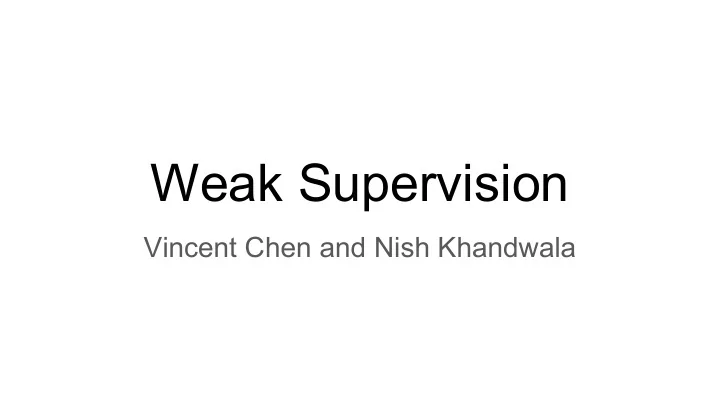

Weak Supervision Vincent Chen and Nish Khandwala
Outline ● Motivation ○ We want more labels! ○ We want to “program” our data! #Software2.0 ● Weak Supervision Formulation ● Landscape of Noisy Labeling Schemes ● Snorkel Paradigm ● Demos ○ Writing labeling functions (LFs) over images ○ Cross modal
Problem 1: We need massive sets of training data! Modern supervised Massive sets of learning hand-labeled data (e.g. our beloved ConvNets!) ● High cost + inflexibility of hand-labeled sets! ○ Medical Imaging: How much would it cost for a cardiologist to label thousands of MRIs?
Problem 1: We need massive sets of training data! Image: https://dawn.cs.stanford.edu/2017/07/16/weak-supervision/
Problem 2: We want to program our data with domain expertise! ● Software 2.0: biggest challenge is shaping your training data ! ● Weak supervision as an approach to inject domain expertise Figure: Varma et. al 2017 https://arxiv.org/abs/1709.02477
Problem 2: We want to program our data with domain expertise! Programming by curating noisy signals! Image: https://hazyresearch.github.io/snorkel/blog/snorkel_programming_training_data.html
Weak Supervision Formulation However, instead of having ground-truth labeled training set, we have: ● Unlabeled data, X u = x 1 , …, x N ● One or more weak supervision sources of the form p’ i (y | x), i = 1 : M, provided by a human domain expert such that each one has: ○ A coverage set, C i , the set of points x over which source is defined An accuracy, defined as the expected probability of the true label, y * over ○ its coverage set, which we assume is < 1.0 ● Learn a generative model over coverage and accuracy Source: A. Ratner et. al https://dawn.cs.stanford.edu/2017/07/16/weak-supervision/
Weak Supervision Formulation Source: A. Ratner et. al https://dawn.cs.stanford.edu/2017/07/16/weak-supervision/
Data Programming - Recent method proposed by Alex Ratner from Prof. Chris Re’s group - Composed of three broad steps: - Rather than hand-labeling training data, write multiple labeling functions (LFs) on X using patterns and knowledge bases - Obtain noisy probabilistic labels, Ỹ --- how? - Train an end model on X, Ỹ using your favorite machine learning model
Data Programming Unlabeled Label Matrix Data, X Ỹ L (N x M) (N points) Labeling functions (M functions)
Data Programming Unlabeled Label Matrix Data, X ? Ỹ L (N x M) (N points) Labeling functions (M functions)
Data Programming How do we obtain probabilistic labels, Ỹ, from the label matrix, L ? Approach 1 - Majority Vote Take the majority vote of the labelling functions (LFs). Let’s say L = [[0, 1, 0, 1, 0]; [1, 1, 1, 1, 0]]. Ỹ = [0, 1] But this approach makes several strong assumptions about the LFs...
Data Programming How do we obtain probabilistic labels, Ỹ, from the label matrix, L ? Approach 2 We train a generative model over P(L, Y) where Y are the (unknown) true labels. Recall from CS109 that P(L, Y) = P(L | Y)P(Y) → we don’t need to know the true labels, Y ! Ỹ can be obtained by taking a weighted sum of LFs’ outputs, where the weights for the LFs are obtained from the generative model training step. Intuition?
Data Programming Putting it all together... Source: A. Ratner et. al https://hazyresearch.github.io/snorkel/blog/weak_supervision.html
Data Programming Putting it all together... Source: A. Ratner et. al, Snorkel: Rapid Training Data Creation with Weak Supervision
Data Programming Framework available on GitHub: https://github.com/HazyResearch/snorkel
Demo: Writing LFs over Images Tutorial: https://github.com/vincentschen/snorkel/blob/master/tutorials/images/Intro_Tutorial.ipynb
Let’s write LFs for this image? Task: Build a chest x-ray normal-abnormal classifier Source: Open-I NLM NIH Dataset
How about now? Task: Build a chest x-ray classifier Can you use the accompanying medical report (text modality) to label the x-ray (image modality)? This setting is what we call “cross-modal”!
Cross-Modal Weak Supervision Y CNN
Cross-Modal Weak Supervision How do we obtain Y? Y CNN
Cross-Modal Weak Supervision LFs Normal Report Source: Khandwala et. al 2017, Cross Modal Data Programming for Medical Images
Cross-Modal Weak Supervision - Approach 1 Majority Vote CNN
Cross-Modal Weak Supervision LFs Normal Report The first two LFs check for abnormal disease terms (in red), and the third LF checks for normal terms (in green). Here, Majority Vote (MV) outputs an incorrect abnormal label, but the Generative Model (GM) learns to re-weight the LFs such that the report is correctly labeled as normal.
Cross-Modal Weak Supervision - Approach 2 CNN
Cross-Modal Weak Supervision - Approach 3 LSTM Y CNN
How good are the labels? Approach 1 (MV) Approach 2 (GM) Approach 3 (DM) 0.75 0.90 0.93 Test set AUC ROC scores (Open-I Chest X-ray Dataset) Source: Khandwala et. al 2017, Cross Modal Data Programming for Medical Images
How good is the image classifier? Approach 1 (MV) Approach 2 (GM) Approach 3 (DM) Fully Supervised (HL) 0.67 0.72 0.73 0.76 Test set AUC ROC scores (Open-I Chest X-ray Dataset) Source: Khandwala et. al 2017, Cross Modal Data Programming for Medical Images
Cross Modal Weak Supervision - Summary Source: Khandwala et. al 2017, Cross Modal Data Programming for Medical Images
Recommend
More recommend